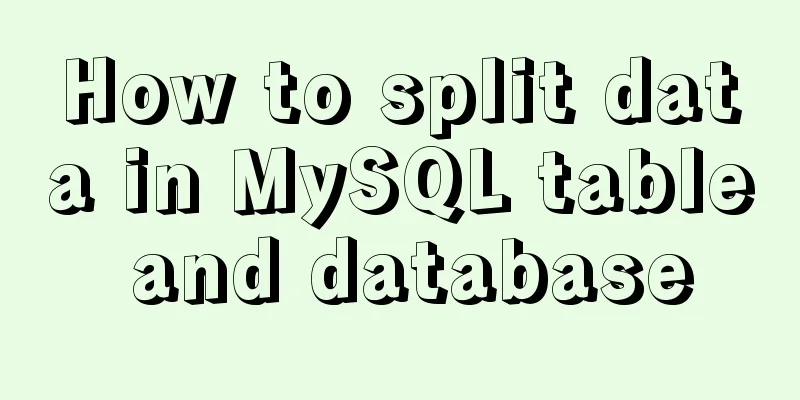How to split data in MySQL table and database

The core content of database distribution is nothing more than data segmentation (Sharding) and the positioning and integration of data after segmentation. Data segmentation is to store data in multiple databases in a dispersed manner, so that the amount of data in a single database becomes smaller, and the performance problem of a single database is alleviated by expanding the number of hosts, thereby achieving the purpose of improving database operation performance. Data segmentation can be divided into two types according to its segmentation type: vertical (longitudinal) segmentation and horizontal (lateral) segmentation. 1. Vertical (longitudinal) slicingThere are two common types of vertical segmentation: vertical database segmentation and vertical table segmentation. 1.1 Vertical DatabaseThat is, based on business coupling, different tables with low correlation are stored in different databases. The approach is similar to splitting a large system into multiple small systems, based on business The categories are divided independently. Similar to the "microservice governance" approach, each microservice uses a separate database. As shown in the figure:
The data tables of different modules are stored in separate libraries. Modules are not related to each other. If so, it needs to be solved through data redundancy or secondary processing. This business method and data structure are the clearest. But if we cannot prevent cross-database related queries, we will declare this path different. 1.2 Vertical table divisionIt is based on the "columns" in the database. If a table has many fields, you can create a new extended table and split the fields that are not frequently used or have a large field length into the extended table. When there are many fields (for example, a large table has more than 100 fields), "splitting the large table into small tables" makes development and maintenance easier and avoids cross-page problems. MySQL stores data through data pages at the bottom layer. If a record occupies too much space, it will cross pages, causing additional performance overhead. In addition, the database loads data into memory in units of rows, so that the fields in the table are shorter and accessed more frequently. The memory can load more data, with a higher hit rate, reducing disk IO and thus improving database performance.
Advantages of vertical segmentation:
shortcoming:
2. Horizontal (cross-sectional) segmentationWhen an application is difficult to split vertically at a finer granularity, or the amount of data rows after splitting is huge, and there are bottlenecks in single database reading, writing, and storage performance, horizontal splitting is required. Horizontal sharding is divided into intra-database sharding and sub-database sharding. It distributes the same table into multiple databases or multiple tables according to different conditions based on the inherent logical relationship of the data in the table. Each table only contains a part of the data, thereby reducing the amount of data in a single table and achieving a distributed effect. As shown in the figure:
Splitting tables within a database only solves the problem of too much data in a single table, but does not distribute the table to databases on different machines. Therefore, it is not very helpful in reducing the pressure on the MySQL database. Everyone still competes for the CPU, memory, and network IO of the same physical machine. It is best to solve this problem by splitting the database and tables. Advantages of horizontal sharding:
shortcoming:
After horizontal sharding, the same table will appear in multiple databases/tables, and the content of each database/table is different. Several typical data sharding rules are: 2.1 According to the numerical rangeDivide by time interval or ID interval. For example: distribute data of different months or even days into different databases by date; distribute records with userId of 1 to 9999 to the first database, records with userId of 10000 to 20000 to the second database, and so on. In a sense, the "cold and hot data separation" used in some systems, which migrates some less-used historical data to other databases and only provides queries for hot data in business functions, is also a similar practice. The advantages of this are:
shortcoming:
2.2 Modulo by valueGenerally, the hash modulus segmentation method is used. For example, the Customer table is segmented into 4 databases according to the cusno field. The data with a remainder of 0 is placed in the first database, the data with a remainder of 1 is placed in the second database, and so on. In this way, the data of the same user will be scattered in the same database. If the query condition contains the cusno field, the corresponding database can be clearly located for query. advantage:
shortcoming:
The above is the details of how to perform data segmentation by sharding MySQL tables and databases. For more information about data segmentation by sharding MySQL tables and databases, please pay attention to other related articles on 123WORDPRESS.COM! You may also be interested in:
|
>>: Website redesign is a difficult task for every family
Recommend
Complete steps to build a squid proxy server in linux
Preface This article mainly introduces the releva...
Implementing add, delete, modify and query operations on MySQL based on sqlalchemy
Demand scenario: The boss asked me to use the cra...
HTML+CSS div solution when relative width and absolute width conflict
Div solution when relative width and absolute wid...
Detailed explanation of the error when using Element-ui NavMenu submenu to generate recursively
When the submenu of the navigation bar is generat...
Tutorial on how to deploy LNMP and enable HTTPS service
What is LNMP: Linux+Nginx+Mysql+(php-fpm,php-mysq...
Solve MySQL deadlock routine by updating different indexes
The previous articles introduced how to debug loc...
Vue.js implements simple folding panel
This article example shares the specific code of ...
Detailed explanation of the use of Vue.js draggable text box component
Table of contents Registering Components Adding C...
10 performance configuration items that need to be adjusted after installing MySQL
In this blog, we will discuss ten performance set...
Discussion on the Issues of Image Button Submission and Form Repeated Submission
In many cases, in order to beautify the form, the ...
15 Best Practices for HTML Beginners
Here are 30 best practices for HTML beginners. 1....
How to deploy code-server using docker
Pull the image # docker pull codercom/code-server...
MySQL learning to create and operate databases and table DDL for beginners
Table of contents 1. Operate the database 1.1 Cre...
A few things you need to know about responsive layout
1. Introduction Responsive Web design allows a we...
Alibaba Cloud applies for a free SSL certificate (https) from Cloud Shield
Because the project needs to use https service, I...














